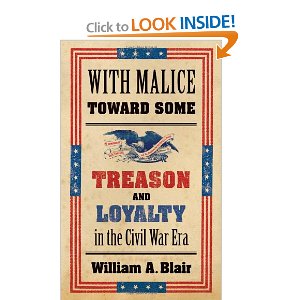William A. Blair
2014, 432 pp., The University of North Carolina Press, $40.00
ISBN: 978-1-4696-1405-2
Image courtesy of amazon.com
While a stream of books are released about the militaristic nature of the Civil War, there are only a handful which deal with the nature of politics in comparison. Those books on politics rarely deal with the subject of treason but now there is an explanation of the term and how it was used during the great conflict. William A. Blair’s With Malice Toward Some deals with the issue of treason and loyalties in the war and the difficulties which it presented. This book is not only a great reference for any Civil War Historian to have on their shelf, but it is a great explanation for those who have been confused about the legal status of treason and the ways in which it was combated during the Civil War.
William A. Blair is a professor of Liberal Arts Research on U.S. History at Pennsylvania State University. He is also the director of the Richards Civil War Era Center and is an editor for the Journal of the Civil War Era which is also published by the University of North Carolina Press. With Malice Toward Some is part of the Littlefield History of the Civil War Era, a sixteen volume series which offers a comprehensive narrative of this era in United States History.
For many who read about the American Civil War, the word treason is thrown around politically quite a bit, but the realization of the effects of the word are different in their meanings than just throwing someone in prison for their treasonous acts. Blair does an excellent job defining for the reader about the many types of treason in a flowing narrative which is quite easy to read. At some points, the reader may feel as though they are reading a law textbook. This should not stop anyone from reading this book, however, since it is one of the advantages of the work. In order to understand about the types of treason, legislative and judicial law must be explained. This type of detail to aid readers is why this book shines as a work on the political front of the Civil War. But beyond treason, he talks about loyalty from both the Union and Confederate side. The constant issues of compliance with the Loyalty Oaths made by certain members of Southern society were not complied with because less than ten percent of the state had not yet given the oath. Taking the Loyalty Oath also opened up the avenue for public ridicule and the status of a social pariah. Blair also spends a chapter on explaining the use and problems with the Provost Marshalls which has been a constant state of debate over the years since the war ended. In a narrative which felt like “who will police the police,” Blair realizes the danger which ensued over the military promoted citizens who felt above the law during the state of war. Blair also deals with politics in the military before 1863 when the Laws of War went into effect, written by Francis Lieber, a German who fled his country because of dangerous political change. The 1863 Laws of War changed many of the issues going on in the army at the time, though the officers and soldiers did not care for them immediately, found solace in their statements as the war went on. Blair concludes this massive undertaking with excellent appendices giving the reader a database of all Court-Martials for treason, disloyalty and Political Arrests Reported in the Newspapers. After reading some examples of treason which I remembered from my studies, I found myself constantly reading the appendices in attempts to see if that person was listed. Overall, after reading this book, there is a better understanding of the word treason and the fine lines which had to be walked before an arrest was made. One such example comes in maritime law dealing with the issues of Privateers. When the Confederacy hired privateers, the men pirating were doing so under the contract of the Confederacy. If the United States tried them, it would be an admittance that the men were under contract from another country therefore recognizing the Confederacy as a nation. It was a fascinating bit of information unknown to most Civil War readers.
I highly recommend this book to any Civil War reader who wishes to know more about the political spectrum of the Civil War. Not only was the narrative quite flowing and easy to read, but the information in the work is unmatched on the subject of treason and loyalty. The wealth of information in the book is so massive that it deserves to be on the bookshelf of any Civil War historian. With Malice Toward Some clarifies many of the issues within Civil War texts concerning arrests and issues of treason and loyalty all around the great conflict.

 RSS Feed
RSS Feed
